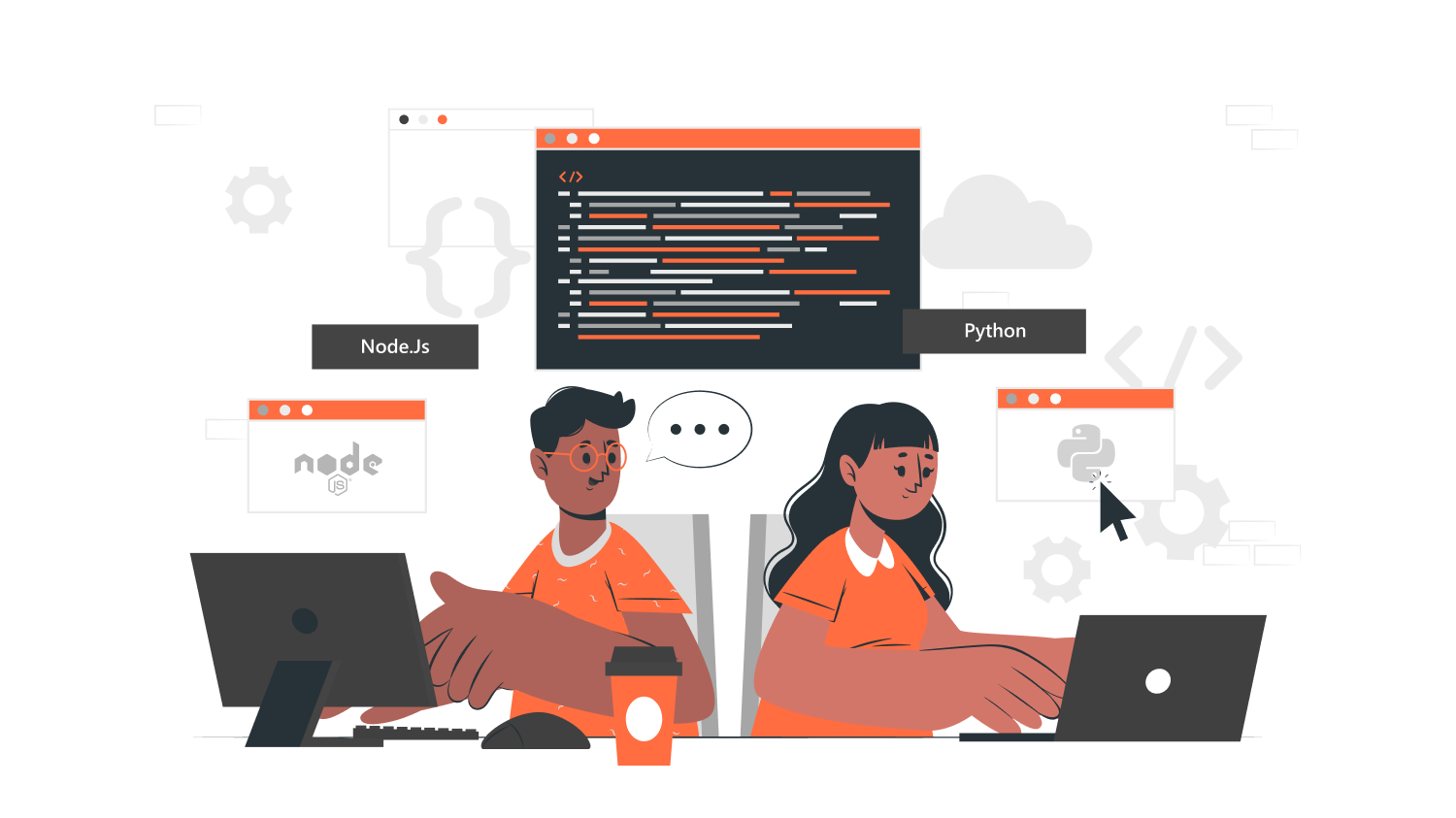Are you looking for a perfect backend programming language for your next project?
Confused between Node.js and Python?
Don’t worry, let’s dig deep into the topic and clarify your doubts. Here we go!
Backend programming language is the backbone of any software project. Node.js and Python are the two of the most popular and widely used backend programming languages.
Comparing Node.js vs Python – both are most powerful, relevant, and have their own pros and cons.
But every project has its own nature and demands. Before starting your next project, it is essential to understand which backend language is the correct fit for you.
Both Python and Node.js have the same function but it has different characters. To select one backend language which suits your project. You will need a detailed analysis of Node.js vs Python.
It will help you choose which language to use for your next project.
Let’s get started.
Understanding Python
What is Python?
Python is a programming language that originated in 1991. Since then,it is one of the topmost backend languages to develop web apps. It offers flexibility, continuous development of diaries, and excellent documentation.
Python is a universal, open-sourced, object-oriented, high-level backend programming language. Python also has the benefit of having access to several tools and libraries which many other Python developers use.
Python is popular for building highly complex web projects. It’s extensively adapted to machine learning, artificial intelligence, and data science.
Python works in frameworks like Flask, Django, Pyramid, Web2Py, and more.
Pros of Python
Let’s look into the advantages of Python that makes it stand out for three decades.
Python has a simple syntax
Python allows the coder to express concepts in just a few lines, making it easier to read and debug. It also makes the code highly readable.
Python is developer-friendly
It is a beginner-friendly language and the mistakes made are easily manageable. Python is taught in various countries and is one of the leading programming languages taught in the US. Python developers are widely available from junior to expert level.
Python has a wide range of libraries
Python has a vast number of libraries that help programmers to build a highly complex application with ease.
Python is easy for AI and ML
It has built-in libraries for artificial intelligence and machine learning. Thus Python makes the work easy for the development of AI and ML.
Python is extensible
Due to its high versatility, Python can be easily integrated with C, C++, Java, and more other languages.
Cons of Python
As usual, all programming languages have their own disadvantages. Let’s look into the cons of Python.
Low speed
Python is in single flow and, also due to many abstraction layers, it consumes more time to process. This factor results in slowing down Python’s speed in server-side management.
Hence Python is not a good choice for projects where speed is most important (Project like high-frequency trading).
Not mobile-friendly
Python makes a good choice for developing servers and desktop platforms. When it comes to mobile computing, it becomes weak because it’s not native IOS or Android language.
We can adapt Python for mobile app development by using it with frameworks and platforms, but the performance will be slow.
Understanding Node.js
What is Node.js?
Node.js is a cross-platform runtime environment; it’s not a programming language. It is used for building fast and scalable server-side and networking applications. It’s not a programming language like Python. Node.js was released in 2009.
Node.js is written using C or C++. It runs on Google Chrome’s high-performance V8 engine.
In Node.js, developers can develop frontend and backend with a single unified stack. Node.js has inbuilt compilers, interpreters, and optimizers.
Pros of Node.js
Node.js was released a decade back. Let’s see what features make it one of the topmost backend programming languages facility.
Node.js is faster than Python
Because of the speed, it’s the best choice for developing chatbox and other similar real-time apps.
Node.js is flexible for microservice development
Since Node.js has a package manager with three modules it enables the developer to edit multiple modules at the same time.
The microservice transition will be more helpful in better maintenance quality and improved testing.
Enables full-stack development
Developers can develop frontend and backend with a single unified stack in Node.js. This feature enables full-stack development with a single team, which is cost-effective for the firm.
Cons of Node.js
Along with the advantages from javascript, Node.js also inherited some disadvantages. Let’s look into them.
Lags in documentation
Python has good comprehensive documentation that Node.js lacks. Unlike Python, there are no libraries or tools present in Node.js, which leads to different options, often leading to certain confusion on what to choose.
Callback feature
Node.js uses a callback feature to track finished tasks. When the project gets bigger, the increased tasks leads to numerous callbacks. There is a possibility to get lost in callbacks and miss out on some technical bugs.
Inability to handle CPU intensive tasks
As Node.js is based on javascript syntax, the CPU consumption rate for processing tasks will be low. The heavy computational request will block the processing of all other tasks and slow down the application. So it’s not friendly with projects based on data sciences.
Comparison of Python vs Node.js
Although Python and Node.js have the same functionality, the difference in characters is in good numbers. Let’s take a closer look at the in-depth comparison of Node.js vs Python in various technical factors.
- 1. Architecture
Architecture is one primary feature to consider before selecting a backend technology. There are two types of architecture.
-
-
- Synchronous – Only one process will be able to run at a time.
- Asynchronous – This allows to run more than one process at a time.
-
Node.js
Node.js is a runtime environment along with a service side asynchronous program. That enables the developer to perform input-output functionality without the interpretation of any undergoing process.
Node.js is event-driven and consists of a single-thread event loop. When this loop combines with Node.js non-blocking nature, it will enable us to manage thousands of concurrent connections without incurring thread context switching.
Due to the above factors, Node.js is an ideal choice for real-time web applications and web games.
Python
Python is not event-driven, and it doesn’t come with an asynchronous server inbuilt. So it doesn’t support multiple process requests. You need to complete one request before starting another one.
Also, with the help of some libraries like asyncio, we can run Python as an event-driven to-built application. But it won’t be as effective as Node.js as it needs some other side hustles.
2. Speed
Developers wish to produce a high-performance application for the user at the end. Speed and performance is an essential feature that every developer will look into before starting a new project with a technology. Here’s the Node.js vs Python performance.
Node.js
As we have discussed earlier, Node.js has a non-blocking architecture. This enables the execution process to be much faster and simpler. Also, Node.js uses the V8 engine that ensures remarkable performance.
Node.js development enables caching fetched data that makes it faster than Python web development. Node.js takes a lesser loading time.
Python
Python’s architecture restricts multithreading affecting the speed and performance. Python is generally slower than compiled languages because of its interpreted language features.
Even though Python’s syntax is easy to understand, it won’t largely help the applications to recall the data. Python is not an ideal choice for projects that need high execution speed.
3. Syntax
Node.js
Node.js possesses a syntax similar to browsers javascript syntax. So if you are familiar with javascript, then it won’t be a huge struggle to understand Node.js.
Python
Python has an advantage while speaking of syntax. Python’s syntax is easier and uncomplicated to understand. It won’t have curly brackets, and it is simple.
It’s easier to debug and read, allowing the client with minimum technical knowledge to understand.
4. Scalability
Scalability refers to the ability of a web application to adapt to changes. Changes like increase in performance, adding new features etc.
Node.js
Node.js helps to create a set of microservices. With these microservices in place, you can communicate with a lightweight mechanism along running its own process. We can easily add a few modules to increase the scalability of an application developed in Node.js.
Node.js has asynchronous technology. Therefore, it supports multithreading.
Node.js helps to create a set of microservices. With these microservices in place, you can communicate with a lightweight mechanism while running its own process.
The development process in Node.js is flexible as you can add the extra modules and microservices easily.
Python
Because of Global Interpreter Lock (GIL), Python doesn’t support multi-threading. GIL won’t allow the Python interpreter to perform tasks simultaneously. GIL ensures that they run only one thread at a time.
5. Learning curve
Node.js
Learning Node.js is easy if you know javascript. Also, installing Node.js is simple. Developers need some time to understand its event-driven architecture.
Python
Python is beginner-friendly due to its easy and understandable syntax. Also, it takes less coding compared to Node.js. Also, it comes with a disadvantage to new developers, even a misplaced bracket may easily break the code.
6. Universality
Node.js
- Node.js has javascript syntax.
- Node.js is used in the backend, and javascript is for the front end. So we can simply use the same syntax for both backend and frontend. It only needs a single team, reducing both cost and time.
- Also, it supports cross-platform which means you can use the single application in macOS, Windows, and Linux. Node.js is more mobile-friendly.
Also Read:Flutter Vs. React Native: Which To Choose For Cross-Platform Development?
Python
- Python is a full-stack language, and it is used for the back end. For the front end, frameworks are used.
- Python is also cross-platform. We can use the same application in all macOS, Linux, and Windows.
- Python is a preferred choice for web development. Unlike Node.js, Python is not mobile-friendly.
7. Extensibility
Extensibility is the ability to add more features and increase the functionalities. The more frameworks you add to a backend the more would be its functionality.
Node.js
Using various tools, We can easily extend, integrate, customise the application with Node.js as backend. Update in Node.js applications is easy. We can also use in-built API for extension and developing DNS and HTTP servers.
Python
Python is also easily expandable.A lot of frameworks and development tools have been introduced since the release of Python in 1991.
For example, you can integrate the Sublime Text code editor with Python. This code editor enables syntax extensions and editing features.
There are many other web development frameworks like Flask, Pyramid, Django which can be integrated with Python for extensions.
8. Libraries
Node.js
- NPM – the Node Package Manager is responsible for the libraries and packages in Node.js.
- NPM has more than 1.3 million packages. You can find your needed package with a simple search in NPM. NPM is one of the largest repositories of software libraries.
- The large number of packages in NPM shows the vast expandability of Node.js.
Python
- Pip – Pip installs Python and manages the libraries and packages in Python. Pip is fast, easy, and reliable to use.
- It has more than 220 thousand packages in a different range of categories like calculation, data science, image processing, etc.
9. Community
Node.js
Even though Node.js is a new technology, it has a vast community. Node.js community is large and active. You can easily find a Node.js developer across the world. Check our nullcast community.
Python
Python is old, and the community is extensively large. You won’t find it hard to hire junior to senior-level developers.
10. Error handling
While coding, errors are inevitable. So the error handling ability of the backend language is more considerable.
Node.js
Node.js is good when it comes to error management. It has a good command in identifying exceptions occurring at the time of code application.
Python
Python is better than Node.js in error handling. It is mainly due to its ability to take less time in troubleshooting bugs and errors than Node.js.
Use cases of Node.js
Due to its ability to perform well in real-time apps, Node.js is adopted over Python for applications that have chat features with their customers.
Some well-known companies using Node.js are:
-
-
- Netflix
- Medium
- PayPal
- Trello
-
Use cases of Python
Due to its uncomplicated syntax, Python is preferred by many giant companies like
Conclusion
Using the above comparison between Node.js vs Python, it’s evident that each has its own characters. Choosing the correct technology on the basis of the project requirements will be wise.
If you are looking for a backend technology to develop a real-time application or a heavy-load app, you can easily adopt Node.js over Python. As Node.js provides faster and asynchronous programming.
But if you are choosing for projects with large databases, with scientific solutions and data solutions, then Python will be a good choice. Python has easy and understandable syntax.
Suggested Read: Should You Hire A Full-Stack Developer or A Team of Specialists For Your Business?




